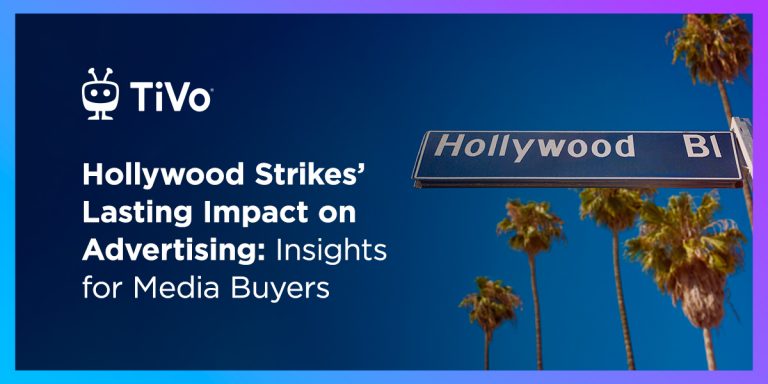By: Laura Stinnett
As the Hollywood strikes finally come to an end, the entire entertainment industry – from actors to studios to advertisers – are starting to adjust to the post-strike landscape. While we adapt to this “new normal,” one thing has become abundantly clear: the entertainment industry won’t be the same.
Amid the strikes, everyone in the entertainment industry had to acclimate to meet the reality of the moment, including those within the advertising industry. Advertisers and agencies were faced with questions around planning campaigns and making media buys.
Similar to the 2008 writers’ strike, broadcasters had to rely on unscripted TV, variety and reality shows, game shows, sports and news to fill the line up. Even though this content was a salve for broadcasters, it could not make up for the usual steady stream of shows viewers – and media buyers who plan around the usual cadence of new scripted content – have come to expect, especially starting in September.
Despite some similarities between the 2008 and 2023 strikes, the entertainment and advertising industries are vastly different than they were 15 years ago. Most notably, there was virtually no streaming in 2008 which was one of the major components of the writers’ and actors’ strikes in 2023. Streaming changed the landscape and will impact how those in the entertainment and advertising industries move forward in this post-strike world. Also, there was no AI in 2008 and today that is a major part of why there were strikes this year.
What Comes Next
The new, post-strike Hollywood is going to be a much leaner one. This business has now gone through a pandemic, a dual strike and an economic downturn. I think there will be more focus on quality rather than quantity of content. Television production’s resurgence will be a gradual process. This ramp-up phase doesn’t solely affect the individuals involved in creating shows and movies – it also necessitates advertisers’ vigilance in navigating the intricate and unpredictable terrain that looms ahead.
Writers have been back at work since October, but as productions start back up again it is not just about getting the actors back to studios and sets. There are other parts at play – from getting crew signed on to products to reserving sound stages. It could easily be another couple of months before new seasons of broadcast shows like Abbott Elementary and Grey’s Anatomy make it to viewers’ screens. This will in turn create challenges in how media buyers will need to develop their post-strike game plans.
One of the considerations media buyers will have to take into account is the content that once performed well pre-strikes may not do well in this “new normal.” While people are itching for their favorite shows to return to their screens, consumers’ attention spans are getting shorter. Given it’s been a year or more for shows to return, many fans may not tune in to those shows they once considered important to them because they have forgotten about the series they once enjoyed.
Advertisers need to understand that people are shifting the way that they watch television and consume content more generally. Businesses will rely on their advertising experts and agencies to refocus and get back on track with their advertising campaigns in this new landscape.
What Media Buyers Need to Know
Now that the actors’ strike has ended, one of the first steps advertisers need to take is to ensure their marketing strategy is still relevant. They should take a fresh look at their target audiences, the messaging and distribution channels and consider whether any of these need to be adjusted in the post-strike landscape.
The recent actors’ strike left an indelible mark on the entertainment industry, shaking the status quo and forcing everyone involved to rethink their approach. In this post-strike period, it’s time for entertainment marketers and their agencies to reflect on the lessons learned and make the necessary changes to navigate the evolving landscape successfully.
No one business is the same but there are some tactics and considerations to take into account that will be beneficial across the board no matter what industry media buyers are making ad buys for.
- Create contingency plans: On a client-by-client basis, media buyers need to create contingency plans for all campaigns and not invest too heavily into one type of activation strategy. As media buyers start to understand the reality of this “new normal,” they’ll need to be agile and not rely heavily on what may have worked previously for their clients’ campaigns and being willing to adapt on the go.
- Invest in CTV advertising: Amid the ramp up, CTV advertising will likely be relatively stable for advertising buys. CTV allows brands to target their precise audience instead of building broad awareness with linear TV, making sure that every dollar goes toward reaching the audience they need to get in front of.
- Data driven marketing: Data analytics and insights have never been more critical. Entertainment marketers and their agencies should harness data to understand audience preferences, track engagement and make informed decisions. This will help tailoring campaigns, optimizing market spends and understanding what works in the post-strike landscape.
- Don’t stop spending: While it may seem prudent to reduce spending on media buys until things get back to normal, advertisers and agencies need to invest dollars wisely. Staying within the space with advertising spend will ensure that viewers don’t forget about a brand and most importantly will not give space for competitors to swoop in and take up the brand’s market share.
- Evolving consumer behavior: Consumers’ behaviors may have changed during the strikes and agencies need to analyze these shifts and adapt their advertising strategies accordingly.
- Adjustments in media planning: The strike may have affected the availability of inventory and advertising opportunities. Agencies may need to revisit their media plans to ensure they reach their desired audience effectively.
- Delays in production schedules: The strikes have led to delays in TV and film productions so advertising agencies will need to revise their marketing strategies and timelines to accommodate the revised release dates.
In summary, now that the strikes have ended, entertainment marketers and their agencies face various challenges including adapting to changes in production schedules, rebuilding relationships and addressing shifts in audience behavior and sentiment. Flexibility and the ability to respond to changing circumstances are crucial during this time.


Comments are closed.